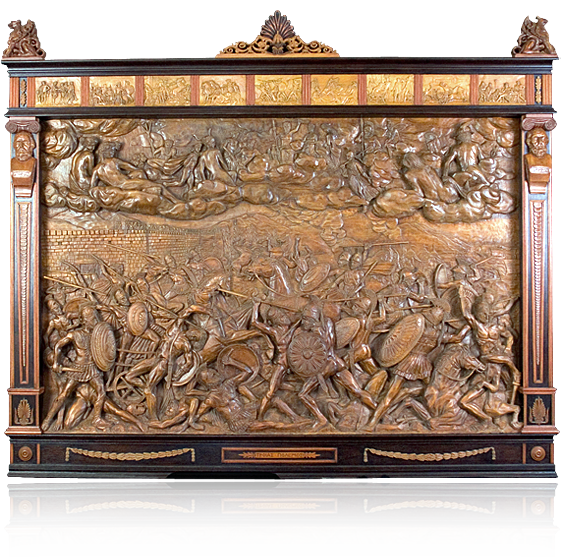| |

POLEMOS TROYAS
Carving in high relief, in dyed and treated maple wood.
84 x 162 x 12 cm
The theme of the main picture, inspired on he illustrations of the Iliad , made by the sculptor Flaxman, is an idealized representation of one of many battles of the “mythic” war of Troy, sung by Homerus.
Observing the compossitive structure of the picture , on the foreground we find the representation divided into two levels: an upper part ,more noble, short of speak, in which over the mortals and on the clouds we can see the Olympic gods reunited, under the presence of Zeus, who holds the thunder ; we can easily identify most of them thanks to their attributes ; they are comfortably contemplating from above, the development of the war events. We can observe that Athena and Apollo are leaving this divine assembly , taking opposite directions in order to protect the confronted parties , Achaeans and Trojans respectively.
The lower part of the picture represents , in the style of old reliefs, the fight strictly speaking, in a scenery with a background made up of the walls of the city of Troy, where we can recognize the famous door “Sceas” and the camp of the Achaeans together with its “concave” naves. The legendary heroes and warriors start a tough combat hand to hand, fighting in general alone and some move with their chariot pulled by an charioteer. As it is known, the two main heroes are, form the Achaean’s side, Achilles, warrior that symbolizes the vigour of youth , and personifies the ideal of friendship , and on the Troyan side, Hector, the humanized hero, strong and courageous fighter, loving husband and tender father. That’s why we can see in the centre and foreground of the picture, the exact moment in which Achilles is ready to cross Hector’s neck with his lance.
To give a perspective of the whole composition , the size of the figures decreases as they go from the spectator , and at the same time they are divided into more than seven levels of depth, from the high reliefs, almost in rounded shape, in which the characters are carved in the foregrounds, to the low reliefs , where the figures and the landscape elements in the distance are represented.
On the other hand, we can see several times the classical triangle as the underlying compossitive structural element, and it is easy to see that all the lower part can be inscribed in a triangular pediment.
The accentuated movement of the lower scene, that contrasts with the tranquillity of the Olympic representation of the upper part of the picture, is achieved by locating the different elements on a net of oblique lines that cross and which most visible exponent is constituted of the lances that the warriors wave. The treatment of the anatomy and clothing of the characters that are represented in a state of maximum tension, contributes as well to accentuate the movement.
In order to give unity to the whole composition , the figures appear interweaved and to accentuate the heroic character of the battle, the characters are naked in some cases, or slightly protected with their helmets and armour, in other cases.
The images in the shape of metope of the upper part of the frame, remind, curved in low relief, nine works of remarkable artists, Flaxman, David, Ingres, J.M.Wagner, Thorwaldsen,etc. They are drawings , paintings and sculptures whose themes have to do with the war of Troy; two heads of Homerus are placed on the pilasters , making two vertical sides of the frame; other ornaments remind , with different stylistic treatment, motives of Classic ornamentation.
Close window |
|
